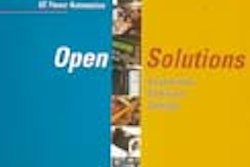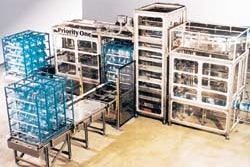The letter was written by James Ingraham, director of software engineering for an industrial robotics firm, Sage Automation, Inc., and has been edited for brevity.
We have been using PC-based controls for more than four years. While your article in the December Packaging World touched on a few of the reasons why we use PCs, it missed several important ones.
First of all, the “determinism” factor of PCs is not an issue. We handle motion control with a DSP-based motion controller or with intelligent servos. All of the loops are closed independently of the PC. So at worst, the system waits a few hundred milliseconds before getting its next move. Since our robots spend a lot of time waiting for something to do anyway, it’s not an issue.
Second, integration is more than just hardware. The fact that I only need one language [for] control, data, HMI and communications is a blessing. On a [PLC], I need one language for control (ladder logic), one for the HMI and one for motion commands. There is no real data handling capability, i.e. a real relation database with logging and reporting capability. No HMI has the power of a full-blown database, even though [some suppliers] claim to have logging and some other functions.
PLC communications schemes are limited; it is difficult to have a heterogenous network of Ethernet, DH+, Modbus+, Profibus, etc. And on top of everything else, the PC is an integrated runtime and development platform. [In contrast,] I have to pull a laptop out to the machine to even look at information on a PLC, much less change the ladder [logic]. A PC can use one language for all tasks, and allow a developer to simply walk up to the machine and make changes, without having to lug a laptop out there.
Third, ladder logic is an [inappropriate] language for some tasks. The way I usually describe it is this: What PLCs are good at, they are very, very good at. For everything else, they are [very difficult]. Procedural machine control is a perfect example of this, especially once a complicated data structure is thrown in. Don’t believe me? Every major PLC manufacturer has recognized the shortcomings of ladder [logic] and provided work-arounds. Siemens and Modicon both add Sequential Function Charts and Function Block Diagrams as part of their IEC-1131-3 implementations. Siemens provides a C compiler with its PLC as the target system. Even Rockwell Automation created a PC-based soft PLC, as well as planning IEC-1131-3 full compliance to their ControlLogix platform.
Make no mistake, traditional PLCs are [limited] outside their niche. You won’t survive as a controls manufacturer unless you can provide an integrated control solution that goes beyond straight ladder logic.
Author David Newcorn responds: Your point about the need to mix logic, HMI and motion control in one programming environment is one that resonates with several users. Indeed, this very point was brought up at the OMAC meeting at Pack Expo Las Vegas in October ’99 by Procter & Gamble (see packworld.com/go/omac). Although still not entirely bullish on PC control, P&G’s Robert Aleksa, corporate controls section head, identified the need for a single programming environment: “[Mixing] logic and motion easily in the same environment is one of our key needs.”
At the end of the day, many end users and machinery builders still feel PLCs are appropriate for machine control. Others are moving into PCs. Packaging World will continue to track the issue, including publishing the results of an exclusive survey that documents the current packaging end-user perspective on PC vs PLC control this summer.


























